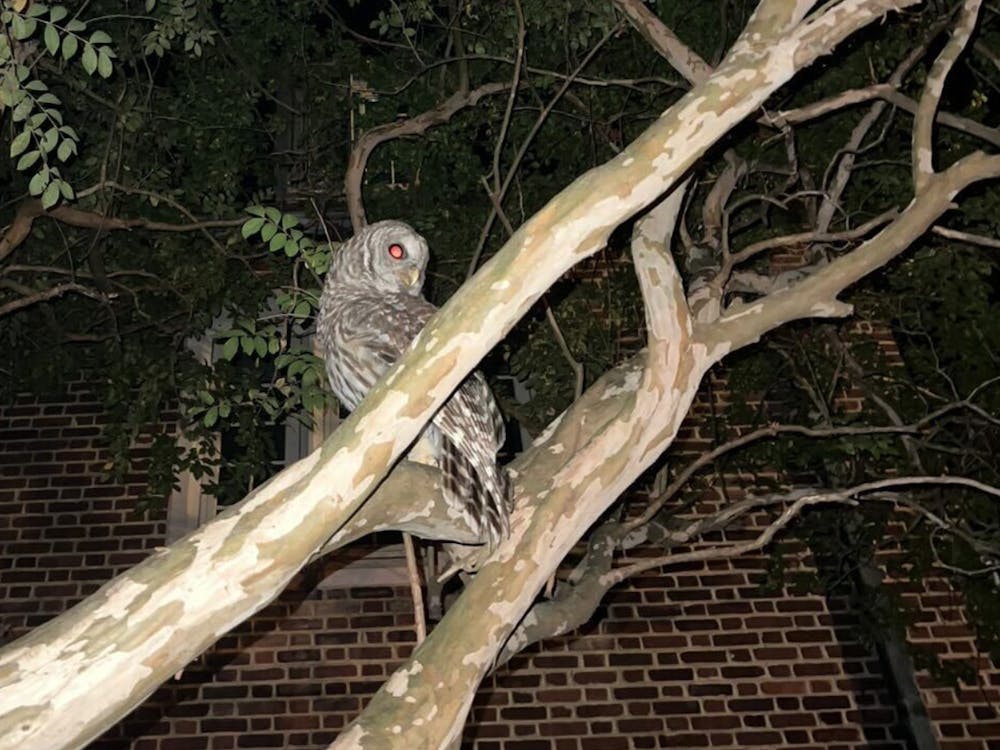A year after the malicious owl attacks on the University of Richmond’s campus, the question on the minds of many members of the community is: Where’s the owl?
Starting in late August of the 2022 fall semester, UR faculty, students and members of the neighborhood surrounding the campus had peculiar run-ins with an unlikely foe: a barred owl. Bloody, close to concussed and frightened students were all across campus. Soon, the administration brought in experts from the United States Department of Agriculture to capture the owl. Their efforts were foiled as the trap used to bait the owl was tampered with and the owl was able to escape. Since then, there hasn’t been more than a hoot from the raptors near campus.
As the cold months set in, owls have been seen across campus, according to videos obtained by The Collegian. However, this shouldn’t be cause for alarm.
Joe Neel, the senior manager of zoology at Maymont, said that most owls, contrary to the behavior of the one at UR last year, typically keep to themselves.
“It is extremely rare that any owls interact with humans, which is made clear by all the attention that the UR owl incident has gained,” Neel said. “Owls, like most birds, are only aggressive toward humans when they are protecting their nests. This particular incident is definitely an outlier.”
Neel reassures that there isn’t any reason to be concerned.
Jeffrey Cooper, the Virginia Department of Wildlife Resources’ bird expert, said that in his 22 years working for the DWR, he’s never seen any kind of owl attacks reported.
“That was the first I’ve heard of a barred [owl] attacking people,” Cooper said. “Some barreds are curious about people and look at them. I’ve had them follow me through the woods but attacking isn’t a real problem.”
In the fall, the owls aren’t too active, Cooper said. Until the late winter, they’re just foraging and mainly located near streams.
“They’ll start breeding, and that’s when you start to hear the call more,” Cooper said. “And they’ll defend their territory against other birds, that sort of thing.”
Cooper reiterated that the owls aren’t a threat to people. He said there are isolated situations where owls will attack humans, but those are not common and there are plans in place to deal with unruly raptors.
Peter Smallwood, a professor of biology at UR, said that starting in December, the barred owls popping up around campus will start to mate and make a bit of a ruckus.
Enjoy what you're reading?
Signup for our newsletter
According to the National Audubon Society, barred owls mate for life and raise one brood, a group of anywhere from one to five eggs.
“They’ll agree to a courtship and make a lot of noise, making sure that everyone knows this is their territory,” Smallwood said.
Smallwood said that despite the eerie sound the owls make, it shouldn’t worry anyone. The owl’s call is loud and recurring to try and court a female and also to tell other males to stay out of their territory.
“There’s a good chance we’ll be able to hear them in December, especially January and February,” Smallwood said. “But I don’t think that there is a reason to expect [attacks]. Yeah, it could happen but it’s just too rare.”
Contact Executive Editor Amy Jablonski at amy.jablonski@richmond.edu.
Support independent student media
You can make a tax-deductible donation by clicking the button below, which takes you to our secure PayPal account. The page is set up to receive contributions in whatever amount you designate. We look forward to using the money we raise to further our mission of providing honest and accurate information to students, faculty, staff, alumni and others in the general public.
Donate Now



